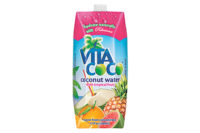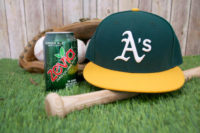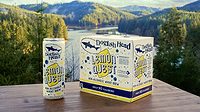Zevia's natural sweetener profile finds home in CSD market
Company expand beyond CSDs with Tonic Water release

Across Zevia’s portfolio of carbonated soft drinks, Ginger Ale, Cream Soda and Cola are the Top 3 performing flavors. (Images courtesy of Zevia)

Zevia entered the mixer category when it released Zevia Tonic Water. Like the rest of the portfolio, it is sweetened with stevia extract, erythritol and monk fruit extract for a zero-calorie, naturally sweetened offering. (Image courtesy of Zevia)

Zevia offers a collection of fruit flavors for consumers who want something beyond traditional offerings. Within its fruit flavors portfolio include Lemon Lime Twist, Orange, Grape, Black Cherry and Strawberry. (Image courtesy of Zevia)

As a seasonal release, Zevia launched Sparkling Apple and Sparkling Pear Celebration Beverages. The winter releases were zero-calorie sparkling juices. (Image courtesy of Zevia)




After much pestering, Sam-I-Am finally was able to get his unnamed friend to try the unfamiliar dish of green eggs and ham in Dr. Seuss’ popular children’s book “Green Eggs and Ham.” Although the unidentified character is rather elaborate about the reasons why he did not want to try the meal, in the end, readers learn how much he has come to embrace the non-traditional item.
Consumers might not be as averse to trying new things, but unfamiliarity can present a challenge for brand owners when they are looking to introduce something new to the market, particularly within an established category like carbonated soft drinks (CSDs).
When Culver City, Calif.-based Zevia LLC launched its line of stevia-sweetened soft drinks in 2007, the product introduced consumers to a new concept: a zero-calorie CSD that uses natural sweeteners. Now, approximately eight years later, the brand has found that not only are consumers embracing the concept, but they’re enjoying the taste profile too.
“One of the big lessons for our brand, which we learned through extensive consumer research, is that consumers view the absence of negatives as a functional benefit,” says Paddy Spence, chief executive officer of Zevia. “In the same way that shoppers gravitated toward diet CSDs a generation ago when they were first introduced — despite what was perceived as an unfamiliar taste profile at the time — Zevia drinkers view the benefits of no artificial sweeteners as a compelling product attribute. This has led to a phenomenon that we call ‘finding your flavor,’ in which shoppers are willing to experiment with various items within the line until they find one or multiple flavors that appeal to them.”
Spence notes that although the CSD category is large in reach and penetration, it has met with its share of challenges as some consumers have expressed concerns about sugar content and sweetener sources for full-calorie offerings as well as consumption of artificial sweeteners, despite their zero-calorie appeal. These challenges have resulted in per capita consumption declines during the past few years, he adds. However, this mindset presented an opening in the market, and one that Zevia was primed to fill.
“In a category that has been growth challenged, particularly in the diet segment, Zevia is a bright spot,” Spence says. “We are the only Top 20 [CSD] brand in total U.S. food growing double digits, and we are bringing shoppers, particularly millennials, back to the category. In addition, the Zevia brand is a significant profit driver for retailers.”
He adds that the company has seen more consumers gravitating toward Zevia. “We stand out on the shelf as an authentic alternative with ingredients about which soda drinks feel good, and that appeal spans a range of demographic segments, retail channels and geographies,” Spence explains.
Noting that last year was a breakout year for the brand in regard to growth in natural and conventional food channels as well as product innovation, Spence anticipates more good things to come in 2015.
“Zevia has all the characteristics of a billion-dollar brand,” he says. “These include velocity and retailer profit contribution at the shelf; strong appeal to the shoppers of tomorrow, such as millennials and Hispanic households; and broad cross-purchasing across flavors by shoppers of the brand.”
Highlighting similarities of the craft beer market, which reached 11 percent of the total U.S. beer market in 2014, according to the Brewers Association, Boulder, Colo., Spence says disruptive CSD brands like Zevia currently account for less than 2 percent of the U.S. CSD market but have room to grow. “Today’s consumers are seeking alternatives to the category leaders, and Zevia is well-positioned to continue to expand our share of the CSD category,” he says.
Fun with flavors
When it comes to discussing Zevia’s achievements in the market, Spence explains that it comes from understanding what appeals to consumers within the CSD category and the health propositions that Zevia can fulfill.
“Zevia’s success has come in part from being a very familiar, yet highly differentiated product line,” he says. “Shoppers recognize our aluminum can and familiar soda flavors such as Cola, Ginger Ale and Cream Soda, yet our zero-calorie, natural sweetener system is unique within the CSD category. To Zevia drinkers, the brand represents a small, easy step they can take to feel better about their and their family’s health.”
Spence notes that Cola, Ginger Ale and Cream Soda are the brand’s top flavor performers in its portfolio, but it also hasn’t been averse to exploring new flavor options. “[B]ecause Zevia is a family brand with strong appeal to kids, fruit flavors have been an important part of our offering,” he says.
Those fruit flavors include Black Cherry, Strawberry, Grapefruit Citrus, Grape, Orange, Lemon Lime Twist and Grape. In addition to its Top 3 flavors and the fruit flavor offerings, Zevia also offers Caffeine Free Cola, Cherry Cola, Mountain Zevia, Dr. Zevia and Ginger Root Beer varieties.
However, the CSD market is not the only space within the beverage industry that the brand has explored.
“In 2014, we launched exclusive items with Whole Foods Market in two segments outside of CSD,” Spence says. “These were our first mixer, Tonic Water, and our Sparkling Apple and Sparkling Pear Celebration Beverages. In both cases, we saw white space in the category. In Tonic Water, no brand had created a zero-calorie tonic water that was naturally sweetened, so that made a lot of sense. Similarly, in the Celebration Beverages category, a seasonal offering popularized by Martinelli’s, lacked zero-calorie options.”
In addition to Whole Foods Market, the company also released Tonic Water on e-commerce site Amazon. Both of these outlets presented a logical avenue to reach consumers for the new products, Spence says.
“Whole Foods Market, and natural-channel retailers in general, have long been venues in which shoppers seek exciting new items and brands, so Whole Foods was an excellent partner for launching Tonic Water,” he says. “Amazon is complementary, in that many shoppers don’t live near a Whole Foods and [instead] can purchase unique items like our Tonic Water online.”
Noting the white space in the market when it comes to tonic water offerings that are not sweetened with artificial products, Spence anticipates that broader distribution could be in store for the new product. “As the first zero-calorie tonic water without artificial sweeteners, Zevia Tonic Water plays a unique role in the mixer category,” he says. “As such, it’s a great item for any retailer that merchandises mixers. We anticipate broad distribution for this item going forward.”
Although the company cannot share any upcoming product launches at this time, it is exploring more opportunities to expand the brand and its health propositions. “Going forward, we see other beverage segments that we believe are ripe for distribution with our zero-calorie, naturally sweetened consumer proposition,” Spence says.
Sweet system
Seeing the potential of stevia-sweetened beverages years ago might have helped launch the Zevia brand, but Spence notes that since then the company always is looking at ways that it can give its consumers the best-tasting zero-calorie, naturally sweetened offerings.
“Zevia has been on a path of continuous improvement in terms of our sweetener system over the past four years,” he says. “We have continued to incorporate higher-purity stevia extracts into our products, and now use a reb[audioside] A 99 percent extract. ”
The company also employed a formulation change to its portfolio of beverages when it added monk fruit extract in 2014. “The addition of monk fruit has allowed us to achieve a slightly sweeter product without the bitter notes that some consumers perceive from stevia-sweetened items,” Spence explains.
After the switch, the company received positive reactions from consumers through their accolades and purchase behaviors. “Consumer reaction to our new formulas has been overwhelmingly positive,” Spence says. “We saw an immediate spike in velocity, even in our most established accounts. Zevia already had excellent conversion from trial to repeat, particularly among millennials, and the ongoing improvements in our sweetener system have continued to drive increased repeat purchasing.”
Packaged to sell
Similar to how Zevia was not afraid to reformulate its sweetener system to offer consumers a better-tasting product, the company also ventured to expand its packaging offerings.
Originally available in 12-ounce aluminum cans, Zevia added a 16-ounce can option and released four-packs of 12-ounce glass bottles in the natural channel in 2013.
“Some shoppers, particularly those in the natural channel, prefer glass bottles to aluminum cans for beverages,” Spence says. “So we introduced versions of our leading Zevia flavors in 12-ounce glass bottles, and they have proven to be incremental to the brand and to the category. Aluminum continues to be our dominant packaging format, but many Zevia fans love to consume our product in glass as well.”
Although the glass bottles are only available in the natural channel at the moment, Zevia is willing to explore other channels. “Foodservice outlets such as upscale restaurants are a great venue for glass bottles, as they tend to present a more premium image than cans,” Spence says. “We are receiving a lot of inquiries from those types of outlets and see significant growth opportunities there.”
The brand also employs a number of packaging strategies to appeal to both the frequent consumer and the trial consumer. Various SKUs are available in six-packs, 10-packs and cases of 24 cans. The 16-ounce cans are available as part of a 12-can case.
“Early on, we made a strategic decision to pioneer the brand on the dry shelf, and that has proven to be a good path,” Spence says. “Currently, 37 percent of Zevia transactions in the food channel are multiple six-packs, so we sell about nine cans per transaction on average. Having now achieved significant success on the dry shelf, we are turning our attention to single-serve.”
He adds that single-serve distribution in the cold space will be an important growth strategy for the brand going forward. “Zevia is an anchor brand in premium/specialty CSDs on the dry shelf, and our consumers are looking to the brand for immediate consumption in the venues they frequent,” Spence says. “These include restaurants, sports venues and other immediate-consumption destinations.”
Branching out
When it comes to marketing and getting Zevia products in front of consumers, the company made headlines last year when it announced that MLB’s Oakland Athletics (A’s) made Zevia’s Ginger Ale, Cola, Ginger Root Beer, Cream Soda, Black Cherry and Grape CSDs available at concessions throughout O.co Coliseum in branded coolers.
The partnership launched at the 2014 Opening Homestand and continued throughout the season. It also included Zevia on rotating billboards behind home plate and as sponsor of the team’s Dot races.Throughout the season, Zevia also participated in on-site sampling for fans and other special events on the 2014 season calendar.
Spence says the brand’s partnership with the Oakland A’s was a fantastic experience for the fans of Zevia and the A’s. “Major League Baseball is a family sport, and about 2 million fans per year attend games at the Oakland Coliseum, so it’s an excellent venue for brands like Zevia,” he says. “In addition, our values really align with those of the A’s. The team has always been innovative and open to doing things differently, so it makes sense that they would be the first franchise in professional sports to offer zero-calorie, naturally sweetened sodas as an option for their fans.”
Although Spence saw the benefits of the two entities teaming up, even he was amazed by how much fans embraced Zevia in its first year in the stadium. “As more and more young people have families, they’re looking for healthier options at the ballpark, and we’ve been surprised by the attention we have received in the stadium,” he says. “Not only have fans been excited that they can purchase a better-for-you soda at the game, but we’re also receiving great feedback from the players and prominent A’s/Zevia fans like Tom Hanks, who tweeted a photo holding our special-edition Oakland A’s Zevia Ginger Ale can last season.”
Zevia is looking forward to continuing the partnership for the 2015 baseball season. “We are getting ready to kick off another season with the A’s this year and will be unveiling some exciting in-stadium promotions,” Spence says. “In addition, we’re speaking with a number of A’s players who love Zevia and anticipate some partnerships there as well.”
Beyond its partnership with the Oakland A’s, Zevia has seen the value in employing a number of different strategies to capture the attention of consumers. “Soda drinkers that discover Zevia tend to want to share their excitement with friends and family, and that has made us a viral brand,” Spence explains. “That, combined with a culture of transparency and authenticity, has led to a very strong following on social media. We believe that the shoppers of tomorrow want to interact with brands, not just view billboards and TV ads, so social media has been a cornerstone of our marketing.”
However, Spence does recognize that despite Zevia’s rapid growth, awareness of the brand still is relatively low when you take into account the budgets and marketing expenditures that category leaders are using.
To break through the barriers of the CSD market, Zevia has found that working with consumers who have discovered the brand and developed a passion for it are strong brand ambassadors. “The ‘80s rapper Biz Markie, who also stars on the popular kids show on Nick Jr.’s ‘Yo Gabba Gabba,’ is a great example,” Spence says. “Biz lost more than 140 pounds drinking Zevia and is an authentic spokesperson who’s equally familiar to young children and 40-something hip-hop fans. He has been a tremendous spokesperson for the brand and aligns well with our fun, family-friendly approach.”
Where to go
With a primary focus in natural and conventional food channels, Zevia products are available across all 50 states and throughout Canada. Spence adds that the company has tested its products in other channels and has seen positive results in the early goings.
Because Zevia’s initial focus was the dry shelf, it has not utilized direct-store-delivery networks for its distribution in the past. However, as it increases its focus on single-serves within the cold case, the company will begin to add those types of distributors to its arsenal in select markets, Spence says.
Although Zevia built up its following in North America, Spence notes that the brand does have international appeal. “Zevia currently ships our products to a number of countries in Latin America, Asia and Europe,” he says. “Our primary focus is North America; however, due to our unique product profile, we have inquiries from around the world.”
Looking for a reprint of this article?
From high-res PDFs to custom plaques, order your copy today!










